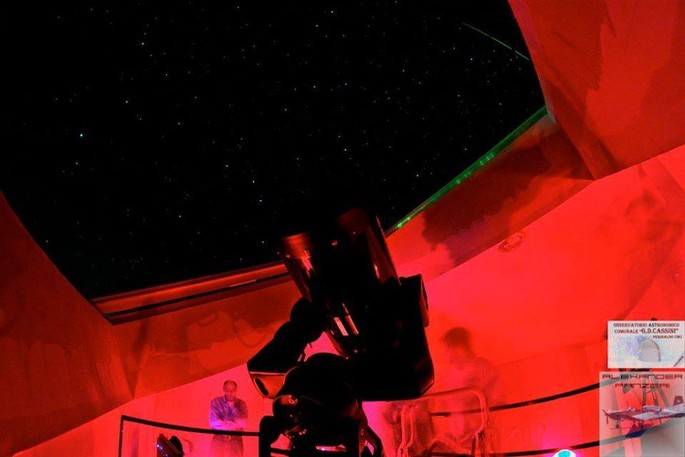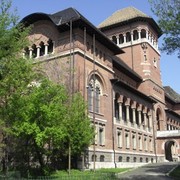Giovanni Domenico Cassini (1625-1712)
was born June 8, 1625 in Perinaldo, in those times land of the Marquis Doria, in the County of Nice, the first of four generations of astronomers. Son of James Cassini, yeoman, and Tullia Crovese, belonging to a wealthy family of notaries. In 1638 he leaves for Genoa, to enter the prestigious Jesuit College, where he completed his studies.
In 1649 he left Genoa for Bologna, where only 25 years old he obtained the chair of astronomy at the prestigious University. In Bologna he passes 20 years of intense study and research, dedicated to the study of comets, those of 1652 and 1664; the study of the Sun, building the Meridiana in the Basilica of San Petronio, which allows him to calculate the exact length of the tropical year, to verify the non-uniformity of the apparent motion of the Sun, to calculate the obliquity of the ecliptic, to define precise Tables of refraction; he observes Mars, Jupiter and Venus which establishes turnaround times; calculate precisely the moments of eclipses of Jupiter's satellites, publishing in 1668 the tables of their ephemeris, fundamental for the determination of longitude and that can be considered a passport for France.
Called by Colbert, minister of Louis XIV, he arrived in Paris April 4, 1669 and remained there for the rest of his life. In Paris, September 14 1671 he enters the Observatoire and will then give report to the Académie des Sciences, of which he is a member. He studied sunspots, eclipses of the Moon and the Sun; organizes expeditions to various parts of the world to coordinate observations, still he observed Jupiter and its spots; Mars, calculates the parallax, which allows him to determine the Earth-Sun distance and then that of all the planets; still observed comets, in 1681-82, he discovers the zodiacal light; He creates a very detailed map of the Moon; but more particularly is concerned with Saturn, of which he discovers four new satellites, two in 1671-72 and two in 1684, its rings, and the division between the rings, said still Cassini Division. In 1694 he parts for Italy, with his son Jacques, for the restoration of the Meridiana of San Petronio, and returns to Perinaldo; Also here, he made observations, from the house and from various locations, including, apparently, the "Tower dell'Alpicella", a small hill not far from the village.
Returning to Paris in 1696. he prepares in the last years of his life, a gigantic work: using at the same time the system of triangulations and his method of determination of longitude, to draw the new map of France, commissioned by the King; Cassini begins the work with Picard and continues with his son Jacques; but the hard work will be completed after almost 130 years by his descendants, Cassini III of Thury and Cassini IV.
Gio.Domenico Cassini died Sept. 14, 1712 in Paris and was buried at Saint Jacques du Haut-Pas, the Parish of the Observatoire.
The dynasty of the Cassini
Giovanni Domenico Cassini I, the founder of a dynasty of astronomers, all born in France and all members of the Académie des Sciences: Jacques Cassini II (1677-1756) César-François Cassini de Thury III (1714-1784) Jean Dominique Cassini IV (1748-1845) Alexandre-Gabriel Cassini Henry V (1781-1832) (Botanical).
Giacomo Filippo Maraldi (1665-1729)
was born in Perinaldo, April 21 1665. The son of Angela Caterina Cassini, sister of Gio Domenico and Francesco Maraldi, architect and master builder of Candeasco (Im). He made his early studies, demonstrating a strong inclination for mathematics, in his early twenties he will be called by his maternal uncle, the famous G.D.Cassini, to Paris and there introduced to the Académie des Sciences.
He arrives in Paris in 1687 and will remain living and working at the Observatory of Paris, next to his uncle, where he will be a valuable employee. In the collections of the Academy, of which he is a member, there are 112 "memories" that testify of his work on various topics, such as comets, that of November 1707, the eclipses of the Sun and Moon, observations of Jupiter and Saturn, on sunspots and the variable stars, in particular those of the Swan, and barometric reading weather. With his uncle and son of these, Jacques, he participates to the measuring of the Meridian of France.
In 1701 he will be in Rome at Pope's Clement XI curia, to care, commissioned by his uncle, the reform of the Gregorian calendar and with Monsignor F. Bianchini, will build the sundial in the Basilica of Santa Maria degli Angeli in Rome; in 1702 he will observe the zodiacal light, already discovered by Cassini. More than forty 'years of his life he has dedicated to the compilation of a catalog of fixed stars, without being able to complete this project. He died on 1 December 1729.
Giovanni Domenico Maraldi (1709-1788)
born in Perinaldo April 17, 1709, son of Giovanni Domenico Maraldi, younger brother of James Philippo and Angela Francesca, from the noble family of Allavena of Perinaldo. Just 18 years old, G.Filippo was called by his uncle, who wanted to start the study of mathematics and astronomy to make him one of his collaborators.
In 1727 he arrived at the Paris Observatory and immediately dedicated to the observations of Jupiter's satellites, which then will affect him for over 50 years, perfecting the 'tables' developed at the time by "Gran Cassini" and corrected by his uncle Giacomo Filippo. After carefully observing the comet of August 1746, he was struck by "une etoile nebuleuse assez claire, qui est composée de plusieurs étoiles" and a few days after he watched another: which were globular clusters now known as M15 and M2.
He contributed to geodetic operations for the Charter of France, with his cousin César-François Cassini de Thury III, performing many trigonometric surveys from 1732 to 1740. In those years he participated in an experiment to measure the speed of propagation of sound waves in the air. In 1740 he recognized the validity of the law on the finite speed of light, enunciated many years earlier by Roemer and decisively rejected from his uncle James Philip, who wanted to support the same thesis of uncle G.D.Cassini.
With weak health, applied for and obtained in 1771 to return to Perinaldo, from where for over 15 years he will send the results of his astronomical observations to the Académie des Sciences.
He died November 14, 1788 and was buried in the parish church of Perinaldo.
Read also our article about the Astronomic Observatory of Perinaldo.














![Hanbury Gardens, itineraries for everyone all year round [Videos] Hanbury Gardens, itineraries for everyone all year round [Videos]](https://www.italyrivieralps.com/typo3temp/pics/g_a7708c6a79.jpg)





